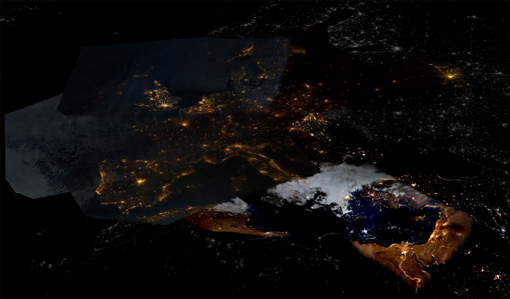
Campus Moncloa
Campus of International Excellence
GUAIX research group has released mosaics of the Earth at Night in the International Week Against Light Pollution
The Universidad Complutense group of Extragalactic Astrophysics and Astronomical Instrumentation (GUAIX), member of the cluster of Global Change and New Energies of the Moncloa Campus has combined nocturnal images of the Earth obtained from the International Space Station (ISS) to create mosaics of the Earth at Night useful to study the light pollution in large areas. Coinciding with the International Week against Light Pollution, they have released the result of combining more than 1,000 images over Europe and The United States of America.
20/04/2012
The Universidad Complutense group of Extragalactic Astrophysics and Astronomical Instrumentation (GUAIX) member of the cluster of Global Change and New Energies of the Moncloa Campus has combined nocturnal images of the Earth obtained from the International Space Station (ISS) to create mosaics of the Earth at Night useful to study the light pollution in large areas. Coinciding with the International Week against Light Pollution, they have released the result of combining more than 1,000 images over Europe and The United States of America.
The intensity and the colors of these images can be used to determine the type of lighting of countries and to calculate the electrical consumption and the energy efficiency in street lighting as never done before. Light pollution, clear in these images, has a high impact on human health and the environment.
High resolution images at night taken by ISS also allow the researchers to measure the intensity of lighting, the source of light pollution and to determine its color. It has recently demonstrated the importance of the type of lamp used, since several studies have revealed the negative impact of blue/white light on human health and the environment.

Image mosaic of Europe, northern Africa and parts of the Middle East in color (ISS).Background image black and white DMSP (NOAA). Original images of Image Scienceand Analysis Laboratory, NASA-Johnson Space Center, ”œThe Gateway to Astronaut Photography of Earth”.
Mosaic: Alejandro Sánchez de Miguel y Jaime Zamorano Calvo, Dpto. de Astrofísica y CC. de la Atmósfera UCM.
This map was made by using thousands of photos taken by astronauts aboard the International Space Station. The final mosaic and distortion correction is a work carried out by the staff of the Dpto. de Astrofísica y CC. de la Atmósfera at UCM using tailor made procedures and free software tools.
According to Alejandro Sánchez de Miguel, prior to the images obtained from ISS, images were only available for large areas of the Earth provided by the DMSP satellite (NOAA) without color information. These images also prevented the researchers to measure the brightness of the most populated areas because they were saturated. These new mosaics were made of images taken with digital cameras capable of recording in three colors (R, G, B) and provide more information because of their greater range of intensities. GUAIX research group works on the absolute calibration of these images to determine the flux emitted into space from each region of the Earth.
Now, they aim to calculate the lighting energy expenditure independently of official statistics provided by countries. The minimum expenditure in the EU in street lighting could exceed 4,000 million euros / year, being in Spain for 450 million euros / year.
Tag: Global Change and new Energies Source: GUAIX
Event date:
20/04/2012
